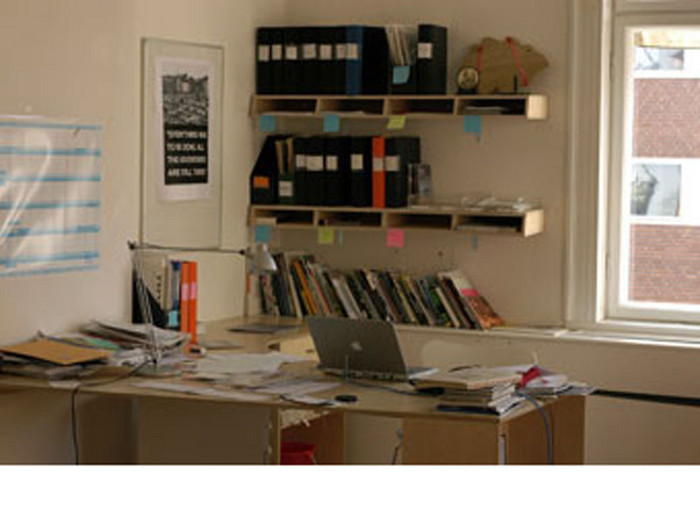Spaces of Conflict
28 Nov 2004 - 09 Jan 2005
Spaces of Conflict
November 28, 2004 - January 09, 2005
Opening: November 27, 2004, 5 - 9 pm
An audio-visual, research based essay on institutional spaces by Mike Bode & Staffan Schmidt
curated by Nina Möntmann, NIFCA
The way people are looking at art institutions is permanently under discussion, and the curators and artists are testing out the role of the museum, or kunsthalle in society. The visitors of an exhibition might ask themselves, in what way insitutional work could be linked to an artistic practice: What would the everyday of an art institution look like? The most trivial things of course, having coffee breaks, monday meetings and answering the mail. But the everydayness of decision making, whose in and whose out, could it be linked to something visual at all?
Mike Bode & Staffan Schmidt portrayed six art institutions in six different countries, by interviewing curators and art students, documenting several familiar or revealing viewpoints of the architecture and its surrounding, and commenting on their own researches. They found out differences and likeness by zooming out and away from the programming of the institutions by opening for questions related to the actual spaces for art. The questions raised are, predominantly, directed towards the expectations that the interviewed have in connection with the spaces. The physical spaces, but also the motives, drives and expectations linked to art and the practice of displaying art. In what way does an art space contribute to the city, to society, to a community? One main topic of interest is the transitional space for art, provided by society, with a history no longer than modernity itself.
It is a history of conflicts, not only in the limited meaning that individuals and different groups have struggled over the right to exhibit, but rather the conflict over a significant space for a societal discourse, and to be more precise: a conflictual discourse over societal space. It has proven impossible but also pointless to keep the distinction intact between actual, physical space and conceptual space: much time had been spent discussing virtual architecture and its possible social effects.
The presentation consists of three parallel videoprojections and two separate audio systems. The length of the audio-visual presentation is 35'37''.
Produced by NIFCA
The project is realized in collaboration with the following institutions:
Statens Museum for Kunst/the x-room and the Schools of Visual Arts of the Royal Danish Academy of Fine Arts in Copenhagen (DK)
Kunsthalle Helsinki and Academy of Fine Arts in Helsinki (FI)
KW Institute for Contemporary Art and Berlin University of the Arts in Berlin (DE)
Contemporary Art Centre and Vilnius Art Academy in Vilnius (LT)
National Museum for Contemporary Art and the National Academy of Fine Art in Oslo (NO)
Rooseum and Malmö Art Academy in Malmö (SE)
November 28, 2004 - January 09, 2005
Opening: November 27, 2004, 5 - 9 pm
An audio-visual, research based essay on institutional spaces by Mike Bode & Staffan Schmidt
curated by Nina Möntmann, NIFCA
The way people are looking at art institutions is permanently under discussion, and the curators and artists are testing out the role of the museum, or kunsthalle in society. The visitors of an exhibition might ask themselves, in what way insitutional work could be linked to an artistic practice: What would the everyday of an art institution look like? The most trivial things of course, having coffee breaks, monday meetings and answering the mail. But the everydayness of decision making, whose in and whose out, could it be linked to something visual at all?
Mike Bode & Staffan Schmidt portrayed six art institutions in six different countries, by interviewing curators and art students, documenting several familiar or revealing viewpoints of the architecture and its surrounding, and commenting on their own researches. They found out differences and likeness by zooming out and away from the programming of the institutions by opening for questions related to the actual spaces for art. The questions raised are, predominantly, directed towards the expectations that the interviewed have in connection with the spaces. The physical spaces, but also the motives, drives and expectations linked to art and the practice of displaying art. In what way does an art space contribute to the city, to society, to a community? One main topic of interest is the transitional space for art, provided by society, with a history no longer than modernity itself.
It is a history of conflicts, not only in the limited meaning that individuals and different groups have struggled over the right to exhibit, but rather the conflict over a significant space for a societal discourse, and to be more precise: a conflictual discourse over societal space. It has proven impossible but also pointless to keep the distinction intact between actual, physical space and conceptual space: much time had been spent discussing virtual architecture and its possible social effects.
The presentation consists of three parallel videoprojections and two separate audio systems. The length of the audio-visual presentation is 35'37''.
Produced by NIFCA
The project is realized in collaboration with the following institutions:
Statens Museum for Kunst/the x-room and the Schools of Visual Arts of the Royal Danish Academy of Fine Arts in Copenhagen (DK)
Kunsthalle Helsinki and Academy of Fine Arts in Helsinki (FI)
KW Institute for Contemporary Art and Berlin University of the Arts in Berlin (DE)
Contemporary Art Centre and Vilnius Art Academy in Vilnius (LT)
National Museum for Contemporary Art and the National Academy of Fine Art in Oslo (NO)
Rooseum and Malmö Art Academy in Malmö (SE)

